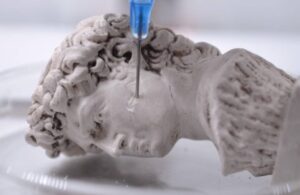Orthopedics

Researchers published a method for 3D-printing an ink that contains calcium carbonate-producing bacteria. The 3D-printed mineralized bio-composite is unprecedently strong, light, and environmentally friendly, with a range of applications from art to biomedicine. [Image courtesy of EPFL]
Researchers in Switzerland are working on a 3D-printable ink that can mineralize to form a high-strength, lightweight bio-composite that mimics the structure and properties of bone. This “BactoInk” contains bacteria that triggers the production of calcium carbonate (CaCO3) without the need for the high temperatures necessary for manufacturing ceramics.
And last year, Stryker opened a 156,000 ft² facility for 3D printing in Ireland. It’s the latest investment in the field by the world’s largest orthopedics company, which has been working with additive manufacturing technology for more than 20 years. 3D printing metal joint replacements, for example, allows Stryker to make more pourous implant surfaces for better bone fixation.
Related: Stryker on steroids: How enabling technology will supercharge surgical robotics
Next>>